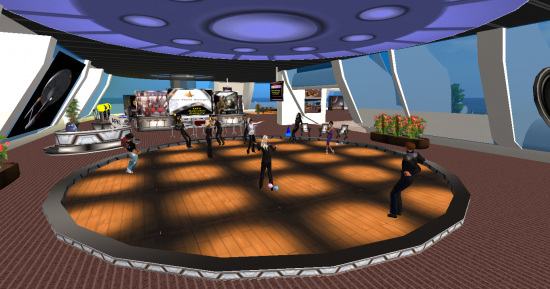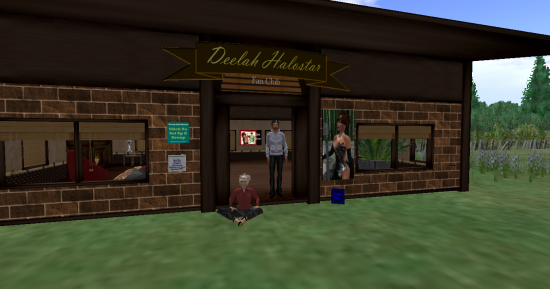In researching today’s news story about Linden Lab terms of services change, content seemed to be the main topic. Protecting it, licensing it, controlling it, owning it.
Everyone wants content. Creators make content, then content attracts users. Without any content, there is no grid. Or is there? Is content really all that important?
I would argue that content is not that important, content is just a side-effect, a symptom of having a good, strong, creative community. And there are three main factors that help create a community, and content is not one of them.
 Those three factors? According to Christine Comaford, those three factors are safety, belonging, and mattering.
Those three factors? According to Christine Comaford, those three factors are safety, belonging, and mattering.
Comaford is the author of the recently-released book SmartTribes, a serial entrepreneur, executive, venture capitalist, and, now, CEO coach. Her ideas about corporate team-building also apply to grid community-building.
“After our essential needs for food and shelter are met, our next level of needs includes safety, belonging, and mattering,” she said in an emailed statement. “People simply can’t perform, innovate, agree, or move forward until those three needs have been met.â€
Trust and safety
How can grids promote trust and safety?
One way of doing so is to have a Terms of Service biased in favor of the customer, not the grid owner — a Terms of Service that isn’t changed without warning or recourse. One that protects creator rights to the fullest extent possible.
But that’s just the beginning.
Can a resident who has budgeted very carefully for their region trust that the prices won’t change in the immediate future?
Do users feel safe? If they are bullied or harassed, is there someone they can turn to? If they have a problem with a merchant, will someone step in and fix it? If they work all week, all month, all year to create a build, will it still be there when they return the next day, or will it be lost to a server glitch?
A grid typically has dozens, or thousands, or millions of such issues coming up. I’m not saying that each and every one has to be settled immediately and to the satisfaction of everyone involved — nobody is perfect, and in a dispute between two residents probably at least one of them is wrong.
But the scale has to tilt towards trust and safety. That way, residents will keep interacting, keep creating, and keep inviting their friends and acquaintances to come join them. If it tilts too far in the opposite direction, residents stop creating, stop recommending. If it tilts even farther, they start leaving.
Belonging
Do residents feel like part of a family?
“It’s an admittedly extreme example, but think about gangs—where people will literally kill to stay in the tribe,†Comaford said. “That’s how powerful this stuff is.â€
Okay, judging by recent flame wars, some residents of social grid do feel very strongly about the virtual worlds they are part of. And while their choice of language might sometimes be problematic, the passion they have for their virtual communities is a great thing.
The question is, how many of a grid’s residents feel that way?
Or do some of them feel left out, less equal than others, stuck on the sidelines while everyone else is having fun?

It is too easy for established residents on a grid to develop an in-group mentality, and look down on newcomers to their grid. It’s a human instinct to be wary of strangers.
The problem, of course, is that social grids need newcomers to compensate for natural attrition, to buy stuff from merchants — the established residents have already bought all they need. Plus, newcomers bring new energy and enthusiasm.
It can take effort on the part of grid management to make newcomers feel welcome, but successful grids make an effort. Greeters in welcome areas help orient newcomers, introduce them around. Mentors can help get them set up and oriented, and find people with shared interests.
Imagine walking into a party where everyone is a stranger to you. You walk in, and everyone turns and stares. Now imagine that you’re naked.
But it can go another way, as well. You walk in and the host is right there, welcoming you, putting a drink in your hand, taking your coat — or, in the case of virtual worlds, giving you a coat — and introducing you around. You instantly feel at home. You belong.
Mattering
Does what residents say make a difference?
One of the benefits of having a small, close-knit grid is that the founders can really listen to the residents, and take their needs into account as the grid evolves.
Grids do this through community forums, open houses, office hours, social media interactions, blog posts and comments, and much more. On some grids, the owners and managers attend grid events, answer resident questions, even take shifts greeting newcomers.
Does the grid have an engaging mission, vision, and set of values that residents contribute to? Are there resident-created rituals that are adopted grid-wide and celebrated by management? Is there transparency to the grid’s operations?
“What I’ve described is the opposite of command and control,†said Comaford. “You engage and enroll. You help people envision an exciting future and invite them to join you in creating it. That’s real influence.â€

How does Second Life measure up?
There are some signs that Second Life is heading in the wrong direction. Recent decisions about mentors, about third-party currencies, and, now, about the terms of service are adding up to a “command and control” style system more appropriate for products that are all about content, such as video games, not products like virtual worlds that are all about building communities.
Does it spell certain doom for Second Life? I don’t know, and probably nobody else does either. Second Life still has a large, strong and engaged user base and it wouldn’t take much to turn things around. A little vision. A little inspiration. A little leadership and some real innovation.
Okay, maybe the word “little” isn’t appropriate. But a turn around is certainly possible, and, I believe, would be good for the metaverse as a whole.
So what about content?
Recently, a grid owner told me he turned off hypergrid connectivity on his grid because people were coming in and copybotting entire regions.
That’s a horrible thing, and I — as someone who makes a living creating content — do not in any way, shape or form condone this kind of behavior.
Of course, turning off hypergrid connectivity isn’t enough. Second Life is rife with copybotters, and it’s nowhere near hypergrid-enabled.
The thing is, I could go out and copybot the most successful grid out there, put up a clone of it, and wait for people to arrive… and wait… and wait…
There are lots of gorgeous — and completely empty — builds out there.
It takes more than content to attract users, especially the kind of users who will stick around, participate in events, and rent land.
It would be the same as if you went and copied all the content on the New York Times site, rented a server somewhere in Even-More-Inner Mongolia, and waited for readers and advertising revenues to roll in. Why would people come to your site — which is only going to stay up until the Even-More-Inner Mongolian authorities finally respond to a take-down request — when they could go to the original New York Times site? Would anybody really trust any stories posted there? Would anyone want to buy an ad?
Or, better yet, consider Yahoo! in the old days, when it was still a simple directory of sites. Copyright law doesn’t apply to directories. Someone could come in, copy-and-paste all their listings, and go into business as competitors. In fact, dozens of companies tried to do just that. Now, Yahoo may be struggling a bit right now, but can you even remember the names of the any of the alternatives?
Say I’m a competing grid and people show up, look around, and say, “Hey, I’ve seen all this before. You’re just like that other grid. Except for the fact that there’s nobody here.”
Worse yet, would-be creators show up, look around, and say, “Nope, can’t trust these guys with content.”
I once interviewed a company that made meditation cushions. Their business model was, you’d go online, order the cushion, get it in the mail, sit on it, and, if you like it, then you’d pay for it.
I wondered about theft. Wouldn’t the company lose a lot of cushions that way to folks seeing enlightenment on the cheap?
“You can’t go far on a stolen meditation cushion,” the owner told me.
The same principle applies to grids as well.
Whether you’re Second Life, or a start-up grid.
You can’t go far on stolen content.
- International singers gather on Alternate Metaverse Grid for first annual International Day - April 15, 2024
- OpenSim hits new land, user highs - April 15, 2024
- Wolf Territories rolls out speech-to-text to help the hearing impaired - April 15, 2024
